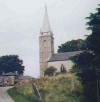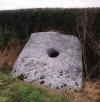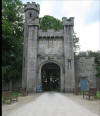AGHADE: a beautiful viewing spot over the River Slaney,
close to the village of Ardattin and an ideal location for
sightseeing and swimming.
-
-

- Aghade lodge
|
-

- All Saints
Church of Ireland, Aghade
|
|
|
|
-
- Aghade Holed Stone ('Clochaphoill')
-
 A
large flat stone, now leaning though originally upright,
with a hole 6 inches wide at one end. It may have been a
so-called 'port-hole' stone which closed the chamber of
a megalithic tomb. However, the traditional explanation
- as usual, much more romantic and appealing - is that
it was a stone used at the dawn of history by Niall of
the Nine Hostages to tie up Eochaidh, son of Enna
Eochaidh broke the chain and took his revenge by killing
the nine men whom Niall had sent to kill him. Up till
the 18th century, sick infants were passed through the
hole to restore them to health!.
A
large flat stone, now leaning though originally upright,
with a hole 6 inches wide at one end. It may have been a
so-called 'port-hole' stone which closed the chamber of
a megalithic tomb. However, the traditional explanation
- as usual, much more romantic and appealing - is that
it was a stone used at the dawn of history by Niall of
the Nine Hostages to tie up Eochaidh, son of Enna
Eochaidh broke the chain and took his revenge by killing
the nine men whom Niall had sent to kill him. Up till
the 18th century, sick infants were passed through the
hole to restore them to health!.
Aghanure
is in the Electoral
Division of Carlow Rural, in Civil Parish of Painestown,
in the Barony of Carlow, in the County of Carlow The
Irish name for Aghanure is Áth an Iúir
Ardattin -
A picturesque country village
south of Tullow, near the River Slaney. Located close by
is Ballintemple House, former seat of the Butlers, a
junior branch of the House of Ormonde and birthplace of
Pierce Butler, signatory of the American Constitution.
Although the house was sadly destroyed by fire in 1913,
an extensive tree nursery tended by the State forestry
service, Coillte, now occupies the Ballintemple Estate. A
circuit walk offering fine views of the surrounding
countryside may be enjoyed through the Coillte site. A
local beauty spot is the Aghade Bridge. There is a local
Museum, which houses The Cottage Collection - Antiques
and Domestic Objects of times past. There is also a local
Ardattin Craft Shop. Ballintemple Nursery & Forest and
Ballintemple House.
Bagenalstown / Muine Bheag
-
This is a medium sized important
and picturesque town on the River Barrow. Its founder William
Bagenal, attempted to build a town of great architectural
importance. His task was never completed, although the many
fine streetscapes of his original plan delight the visitor.
Other places of interest are Dunleckney Manor, which is one
of Carlow's most magnificent country houses located 2km north
east of Bagenalstown. Incorporating the original manor dating
to 1612. The present manor was erected in 1845 in Tudor
Gothic style by Daniel Robertson. The manor was home to the
Bagenal family for almost three centuries from 1585 onwards.
Hillview Museum, Corries - Household artefacts and vintage
farm machinery. Carrigbeg Equestrian Centre, Fennagh. The
ruins of the early 14th century Ballymoon Castle, near
Bagenalstown enjoys public access from the road. Wells
Church, Bagenalstown. Preserved ruin of a church dating back
to 1262. The present remains consist of the east and most of
the south wall, and the reconstructed north wall of the nave
BALLINKILLEN: South of Bagenalstown off the Bagenalstown
- Borris road is the village of Ballinkillen, nestling under the
shadow of Mount Leinster. In the village churchyard are the
gravestones of the parents of the late Cardinal Moran & Theresa
Malone - the 1798 heroine of the "Battle of Kilcumney". The village
has a very fine Community Centre, with all the various indoor
sports activities and a splendid G.A.A. sports field. Teresa
Malone is buried at Ballinkillen Chapel yard. She features in the
Ballad of Kilcumney and is a heroine of 1798 because she distracted
the crown army as they chased after rebels of 1798. She shot a
soldier and rode off to the rebels. It is said that Teresa Malone
lived until she was 90 and died around the time of the Fenian
rising of March 5, 1867 and because of this there was a big media presence at her
funeral as they feared there would be trouble.
|
Ballon

This picture of Ballon
appeared in the Carloviana 1995
A charming rural village
situated on the main Carlow/Wexford Road, with excellent
views of the Blackstairs and Wicklow Mountains. Evidence of
human habitation in the village can be dated back to the
Bronze Age and a settlement has been found on Ballon Hill.
The visitor can enjoy a walk of approx 3 km the settlement on
Ballon Hill. The Church of St. Peter & Paul is also well
worth a visit. Altamont Gardens, the most Romantic Gardens in
Ireland. Ballon is a charming rural village with excellent
views of the Blackstairs and Wicklow Mountains. The village
is lively and atmospheric, offering the visitor a range of
entertainment's and social events. Do you have a poem in you?
Rathoe is situated between Tullow and
Ballon, a small friendly village made famous by Bard van
Vousden who wrote the song “The Roads Around Rathoe”. St.
Patrick's Church is an excellent example of 19th century
craftsmanship with beautiful stained glass windows.
|
Ballymoon Castle -
near Bagenalstown. It was occupied in late medieval times by
the Kavanagh's, who controlled all but two of Co Carlow’s 150
castles during the early decades of the 15th century. Like so
many Irish castles, Ballymoon has no recorded history, but on
architectural grounds it must have been built c.1290-1310.
The most likely builders were the Carew family, who evidently
by this time had acquired the district (Idrone), from the
Bigods, Earls of Norfolk. The castle - as striking as it is
unusual - comprises a courtyard about 80 feet square,
delimited by granite walls, 8 feet thick and 20 feet high. No
doubt these walls had allures or wall-walks with
crenellations, but these do not survive. Some flanking
protection was provided by oblong latrine turrets projecting
from three of its faces; the fourth curtain on the west has
no such defence, though the gateway on this side, a plain
arch with portcullis grooves, may origin ally have had a
barbican in front. The interior is now bare, but the walls,
many embrasures, loops, fireplaces and doors bear witness to
the former presence of two-storey ranges, some with cellars,
that delimited the enclosure. The fine double-fireplace on
the north belonged to the Great Hall, while such features as
the cross loops with expanded terminals and "Caernarvon
arches" allow us to date the castle to the turn of the
thirteenth century. The castle may not have been in use for
very long; indeed, some argue it was never finished. Located
2 miles E of Bagenalstown in a field adjacent to the Fennagh
road (L33). A small bridge gives access across a deep field
ditch.
- BESTFIELD or DUNGANSTOWN:-
- Upon
Ducanstown (Dunganstown) stands a castle. This castle was
probably standing on an island in the River Barrow as indicated
on the Down Survey of 1650. Built by the St. Leger family.
Subsequently passed to the Butler family before passing on to
Bests. It probably stood close to or on farm buildings. Over the
years stones from the ruins have been carted away for building
purposes to the Larchfield estate, but some traces of the walls
are still clearly discernible on the east bank of the Barrow.
 Bestfield Lock
Bestfield Lock
Ballymurphy and Tinnacarrig
- Ballymurphy is obviously ‘the
townland of Murphy’, Tannacarrig was ‘the house of the rock’.
Within a half mile of Ballymurphy Chapel was the remains of
an old church and graveyard called Kilcullen (Cullen’s
church). A large number of chiselled stones, probably from
the church lay scattered around. A holy well called Kilcullen
Well was close by, in the 1860’s this was still visited by
pilgrims. Patrick Breen was from near Ballymurphy. He
was born in 1795 and in 1846 to 1847 himself and his
family were part of 87 pioneers in America who set off on
a wagon train for California and found themselves trapped
by snow in Sierra Nevda. They were called the Donner
Party volunteers- named after George Donner, their
leader. Patrick Breen from Ballymurphy brought his wife
and seven children and they all survived. Of the 87
pioneers on this journey, 39 died. Patrick Breen kept a
diary of his time. It was reported that some of the
people who survived did so by eating the flesh of their
dead companions and the indian guides. They were trying
to find a faster route across Utah and Nevada. The Breens
ended up living in California in a place called San Juan
Bautista, California.
Ballynagraine -
Ballynagraine is thought to be derived from the Gaelic Baile
na Grian, ‘the townland of the sun’. This was the seat of the
powerful Kavanagh dynasty. A church, 85 feet long and 16 feet
wide stood here. It had a special aisle, which is thought to
have been for the private use of the Kavanagh/Butler family.
It is thought that this church came to be built as a
consequence of the church at Clonygoose being torn down by
some Protestant men in Penal times.









